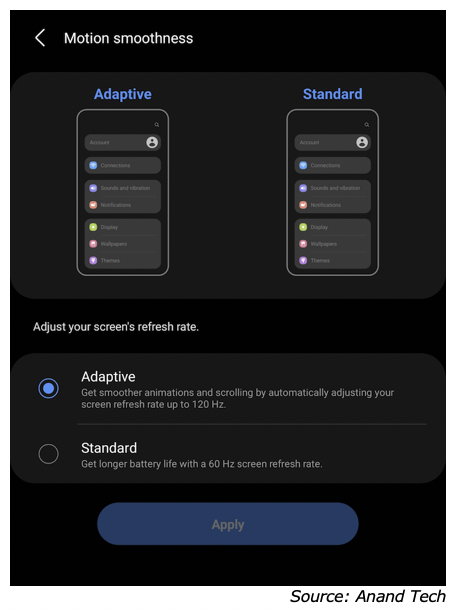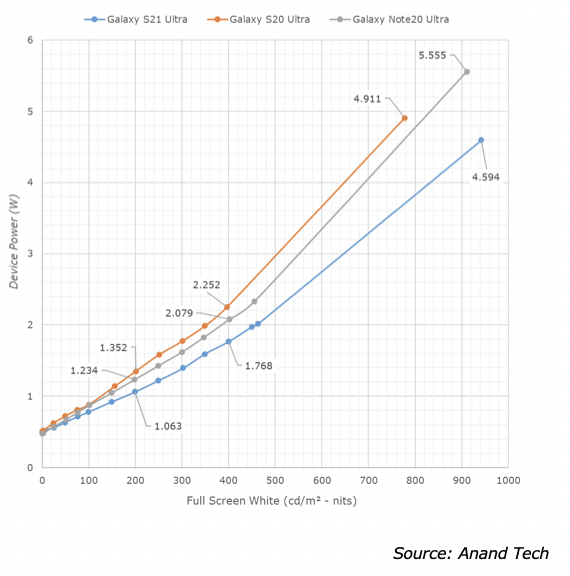Vertical Divider
Samsung’s S21’ Material Stack is 26% to 31% More Efficient than the S20
Samsung’s S21 Ultra display supports 1440 x 3200 resolution at 120Hz – an option that previously wasn’t possible on the S20 or Note20 series devices. Samsung’s approach is similar to the OnePlus 8 Pro: the MIPI interface clock has been upped from 1157MHz to 1462MHz. It’s still a single 4-lane interface in terms of width, but like on the 8 Pro, the increased frequency allows for sufficient bandwidth to now enable the high refresh rate at high resolution.
Figure 1: Samsung S21—Motion Smoothness Settings
Samsung’s S21 Ultra display supports 1440 x 3200 resolution at 120Hz – an option that previously wasn’t possible on the S20 or Note20 series devices. Samsung’s approach is similar to the OnePlus 8 Pro: the MIPI interface clock has been upped from 1157MHz to 1462MHz. It’s still a single 4-lane interface in terms of width, but like on the 8 Pro, the increased frequency allows for sufficient bandwidth to now enable the high refresh rate at high resolution.
Figure 1: Samsung S21—Motion Smoothness Settings
The panel of the S21 Ultra, much like the Note20 Ultra uses an LTPO backplanes, which supports allows it to enable low refresh rates and seamless switching between refresh rates. VRR (variable refresh rate) works transparently to the hardware, and the LFD (low-frequency drive) is able to achieve great power efficiency benefits when in the “Adaptive” screen refresh rate mode. The behavior of the VRR mechanism is not functional in low ambient brightness situations, with power consumption varying depending on what the ambient light sensor of the phone is picking up, which means that when in brighter situations where the ambient light sensor detects luminance beyond 40 lux, the VRR and LFD are working seemingly as intended. Samsung’s approach to implementing VRR is covered in our Musing on Technology Section
The Galaxy S21 Ultra display is the first to use a new generation OLED emitter. Over the years, there have been noticeable jumps in OLED power efficiency, and most of them have been tied to introductions of new generation emitters which improved upon their predecessors. UDC typically, provides a new generation of red and green each year and Samsung will adopt the upgrade after qualifying it unless they have been left with a big inventory.
Comparing the power consumption of the new Galaxy S21 Ultra to the previous-gen S20 Ultra as well the Note20 Ultra in shown in the next figure:
Figure 2: Power Consumption vs. Luminance
The Galaxy S21 Ultra display is the first to use a new generation OLED emitter. Over the years, there have been noticeable jumps in OLED power efficiency, and most of them have been tied to introductions of new generation emitters which improved upon their predecessors. UDC typically, provides a new generation of red and green each year and Samsung will adopt the upgrade after qualifying it unless they have been left with a big inventory.
Comparing the power consumption of the new Galaxy S21 Ultra to the previous-gen S20 Ultra as well the Note20 Ultra in shown in the next figure:
Figure 2: Power Consumption vs. Luminance
The various devices start off at roughly the same baseline power consumption starting point on a complete black screen: 481mW for the S21 Ultra, 510mW for the S20 Ultra, and 476mW for the Note20 Ultra. We’re measuring things in the 60Hz mode as we’re just focused on the luminance power of the displays. Compared to the S20 Ultra, at 200 and 400 nits, the S21 Ultra is roughly 22% more efficient when displaying full screen white, which is a huge number given that total device power is measured and not just the display.
Figure 3: Power Consumption vs. Luminance Normalized
Figure 3: Power Consumption vs. Luminance Normalized
By normalizing the power curves to the baseline power, the S21 Ultra is actually even more efficient – 26% to 31%, depending on brightness level. Although the new S21 Ultra’s screen is the brightest that Samsung has ever delivered, reaching full screen white levels of up to 942 nits, it uses less power than the S20 Ultra’s 778 nits peak brightness. The peak power is also 20% lower than the Note20 Ultra even though it’s also brighter by 31 nits. The S20 Ultra and the Note20 Ultra power curves roughly match up to around 150 nits, after which the Note20 Ultra takes the lead, however the advantage seems to be fixed in terms of absolute mW, as the power curves continue to run in parallel to each other – it could be the efficiency gains come from the new backplane technology of the Note20 Ultra. The S21 Ultra’s power curve is clearly more divergent at increasing brightness levels, which is a sign of improved luminance efficiency as opposed to panel drive efficiency, which is exactly what we’d expect given the new emitter technology. By normalizing the power curves to the baseline power, the S21 Ultra is actually even more efficient – 26% to 31%, depending on brightness level. Although the new S21 Ultra’s screen is the brightest that Samsung has ever delivered, reaching full screen white levels of up to 942 nits, it uses less power than the S20 Ultra’s 778 nits peak brightness. The peak power is also 20% lower than the Note20 Ultra even though it’s also brighter by 31 nits. The S20 Ultra and the Note20 Ultra power curves roughly match up to around 150 nits, after which the Note20 Ultra takes the lead, however the advantage seems to be fixed in terms of absolute mW, as the power curves continue to run in parallel to each other – it could be the efficiency gains come from the new backplane technology of the Note20 Ultra. The S21 Ultra’s power curve is clearly more divergent at increasing brightness levels, which is a sign of improved luminance efficiency as opposed to panel drive efficiency. From Anand Technologies
|
Contact Us
|
Barry Young
|



